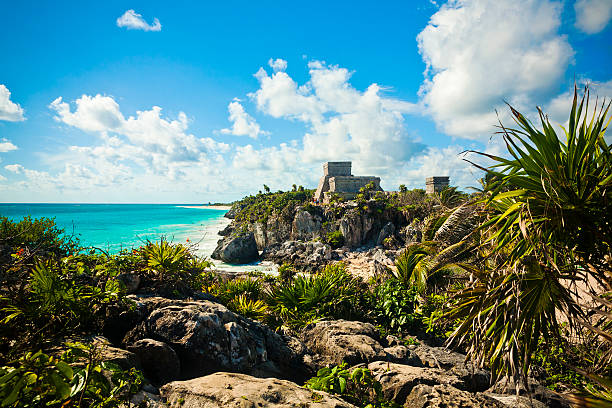Tulum, with its stunning beaches, ancient ruins, and vibrant culture, has become one of the most sought-after destinations in the Riviera Maya. However, with its growing popularity comes the challenge of preserving its natural beauty and cultural heritage. As travelers, we have a responsibility to minimize our impact on the environment and support the local community. In this guide, we’ll explore how you can experience Tulum in a sustainable way, from choosing eco-friendly accommodations to supporting local businesses and practicing responsible tourism.
1. Stay in Eco-Friendly Accommodations
One of the best ways to ensure your visit to Tulum is sustainable is by choosing eco-friendly accommodations. Tulum is home to a variety of eco-conscious hotels and resorts that prioritize sustainability without compromising on comfort or luxury. These properties are designed to blend seamlessly with the natural environment, using sustainable materials, solar power, and water conservation practices.
Azulik is a prime example of an eco-luxury resort in Tulum. This adults-only retreat is built from natural materials and operates without electricity in the guest rooms to reduce its carbon footprint. Instead, the resort uses candles to create a serene, romantic atmosphere. Azulik also focuses on preserving the surrounding jungle and coastline, offering guests an immersive experience in nature.
Another excellent option is Habitas Tulum, a sustainable hotel that emphasizes community and connection. The hotel is constructed using local, sustainable materials and offers wellness programs, including yoga and meditation, that connect guests with the natural surroundings. Habitas also works with local artisans and farmers to source food and decor, ensuring that your stay supports the local economy.
2. Support Local Businesses and Artisans
Sustainable travel isn’t just about protecting the environment; it’s also about supporting the local community. Tulum offers numerous opportunities to shop from local artisans, dine at family-owned restaurants, and participate in cultural experiences that directly benefit the people who live there.
When it comes to shopping, avoid mass-produced souvenirs and opt for handmade crafts from local artisans. The Tulum Art Club is a great place to start, offering a variety of artwork, jewelry, and crafts made by local artists. You can also visit the Sfer Ik gallery, which showcases contemporary art in a stunning eco-friendly space, supporting the region’s cultural heritage.
Dining at locally-owned restaurants is another way to contribute to the community. Skip the international chains and enjoy a meal at places like Taqueria Honorio, known for its traditional Yucatecan tacos, or Cetli, which offers a gourmet take on Mexican cuisine using locally sourced ingredients. By choosing to eat at these establishments, you’re helping sustain local businesses and keep Tulum’s culinary traditions alive.
3. Practice Responsible Tourism
While Tulum’s beaches and cenotes are undeniably beautiful, they are also delicate ecosystems that require our protection. Practicing responsible tourism means being mindful of your impact on these natural wonders and taking steps to minimize it.
When visiting the Tulum Ruins or other archaeological sites, respect the rules and guidelines set by the authorities. Stick to marked paths to avoid damaging ancient structures, and refrain from touching or climbing on the ruins. It’s also important to avoid leaving any trash behind and to be mindful of the natural surroundings.
Tulum’s cenotes, natural sinkholes filled with crystal-clear water, are another popular attraction. However, these cenotes are fragile ecosystems that can be easily disrupted by human activity. Before taking a dip, make sure to shower to remove any sunscreen, lotion, or other chemicals that could contaminate the water. Consider using biodegradable sunscreen, which is less harmful to the environment. When swimming, avoid touching the walls or disturbing the underwater formations, and always follow the guidelines provided by the cenote operators.
4. Choose Eco-Friendly Transportation
Transportation is a significant factor in reducing your carbon footprint while traveling. In Tulum, consider eco-friendly transportation options that have a lower impact on the environment.
Biking is a popular and sustainable way to get around Tulum, especially since many of the main attractions are within cycling distance. You can easily rent a bike from one of the local shops or your hotel and explore the town and beach at your own pace. Not only is biking eco-friendly, but it also allows you to take in the sights and sounds of Tulum up close.
For longer distances, opt for public transportation or shared rides. The ADO bus system is an affordable and efficient way to travel between Tulum and other destinations in the Riviera Maya. Alternatively, you can use local colectivos, shared vans that run along the main highway, which are a more sustainable option than private taxis.
5. Engage in Eco-Tours and Volunteer Opportunities
Tulum offers a variety of eco-tours that allow you to experience the natural beauty of the region while contributing to conservation efforts. Whether you’re interested in exploring the Sian Ka’an Biosphere Reserve or learning about sea turtle conservation, there are plenty of ways to get involved.
Mexico Kan Tours offers eco-friendly tours that focus on sustainable practices and education. Their tours include visits to cenotes, snorkeling in the coral reef, and exploring the Sian Ka’an Reserve, all while minimizing the environmental impact. The guides are knowledgeable about the local ecology and culture, ensuring that your experience is both enjoyable and informative.
If you’re passionate about conservation, consider participating in a volunteer program during your stay. The Sea Turtle Conservation Project in Tulum offers opportunities to help protect endangered sea turtles by participating in nest monitoring, hatchling releases, and beach cleanups. Volunteering not only gives you a chance to give back to the environment, but it also provides a deeper connection to the place you’re visiting.
6. Reduce Plastic and Waste
Plastic waste is a significant issue in many tourist destinations, including Tulum. As a traveler, you can make a difference by reducing your plastic consumption and minimizing waste during your trip.
Start by bringing a reusable water bottle to avoid buying single-use plastic bottles. Many hotels and restaurants in Tulum offer filtered water stations where you can refill your bottle. You should also carry a reusable tote bag for shopping and say no to plastic straws, utensils, and bags whenever possible.
When dining out, consider bringing your own container for leftovers or takeout, which helps reduce the amount of single-use packaging. Supporting restaurants that prioritize sustainability, such as those that use biodegradable packaging or source locally, also contributes to reducing waste.
Conclusion
Traveling sustainably in Tulum isn’t just about reducing your environmental impact; it’s about making conscious choices that support the local community and preserve the natural beauty of this incredible destination. From staying in eco-friendly accommodations to practicing responsible tourism, there are many ways to enjoy Tulum while being mindful of your footprint. By following these tips, you can have an unforgettable experience in Tulum, knowing that you’ve contributed to the sustainability of this paradise in the Riviera Maya.














